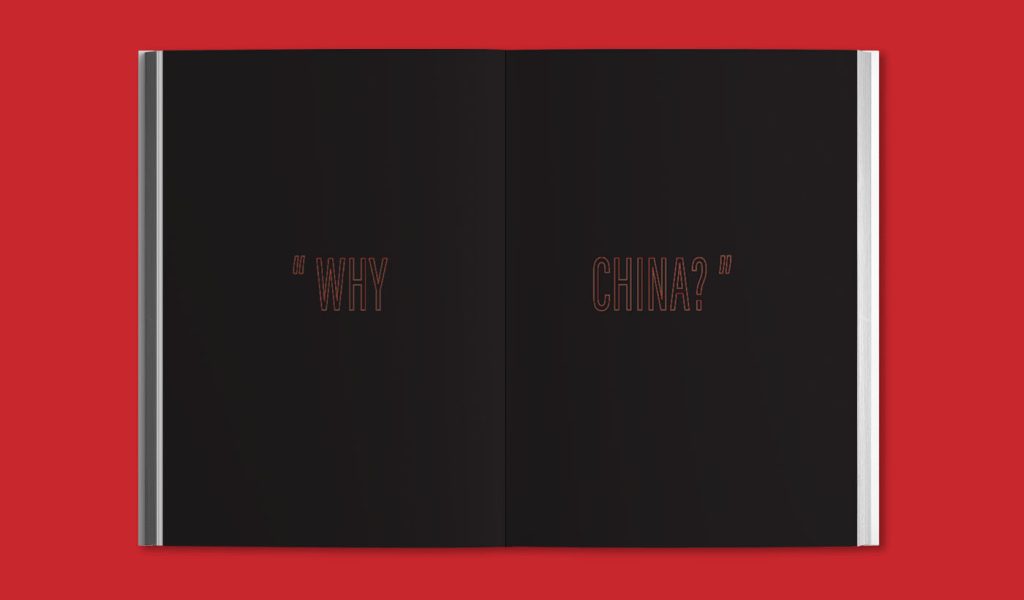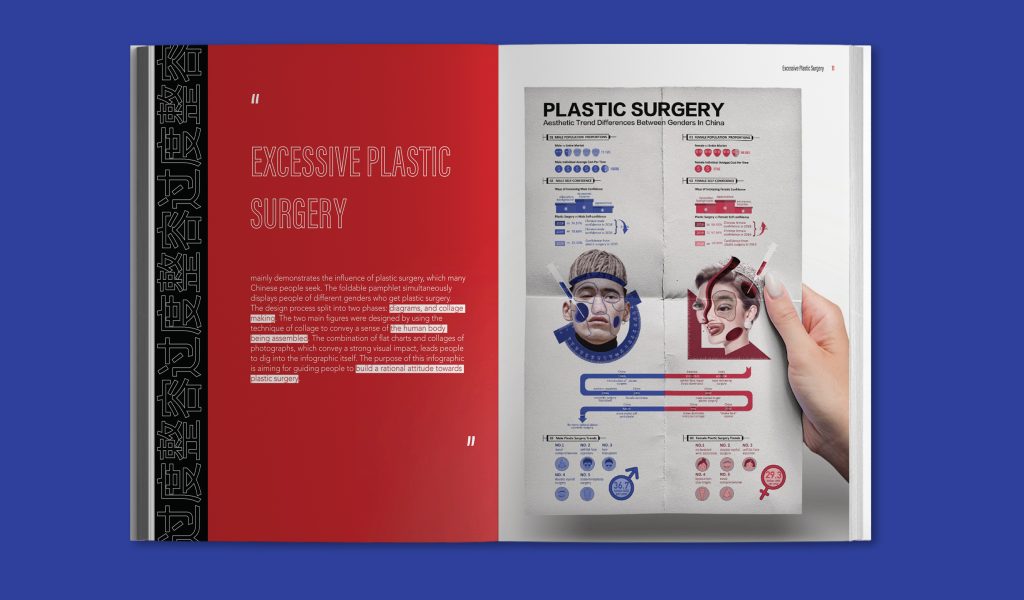My Design Narrative: Behind the Book With Chen Gao
Artist and graphic design professor Chen Gao shares the story of making her captivating portfolio, My Design Narrative. A lover of books and lifelong learning, Gao speaks about inspiring her students through critique as well as the importance of print in a digital world. Follow her on Instagram at chengaoart.
What first got you interested in art and graphic design?
It happened in 2018. I got a juried student exhibition and sold my work when I was in undergraduate school. The work I submitted was a class exercise, not a class project. Before that, I had been eager to learn and practice in the field, but this exhibition made me feel “achievement” for the first time. After that, I began to be interested in art design.
You describe your portfolio as a first-person narrative that expresses your feelings about having a Chinese background. Who is this portfolio for, and what do you hope they learn?
The feelings are represented in a first-person narrative that depicts my background and experience. It illustrates the person (myself) who lived outside their homeland for several years and shared feelings about being distanced and lost in the conjunct place. My audience, who has shared similar experiences, will hopefully feel less alone. No matter what happens, we are all together. You are not just standing by yourself, and you are not alone.

Your work has taken many shapes: drawing, photography, poetry, installation, and performance. How does a book on graphic design fit into this landscape?
I make work by following my emotions and instincts. It is a journey that is always in motion, which is the process I use to find myself. So, in this case, it can be in any medium that depends on my feelings and specific situations.
When it turns into graphic designs, it is still the same logic. I love design books because they are multiple pages. Eyes can move through the pages. Hands can feel the touches. Comparing other graphic designs, the books make me feel more. Some books feel soft; some are hard. Some have a natural feeling; some are more standardized. Each book, like each person, has a different personality. They are so unique to me. The way I love books is the same as how I follow my feelings to make other mediums of work. I can feel, think, and create.
What role do you think print plays in a digital world?
The digital world can affect print from different perspectives. With the rapid evolution of emerging technologies, digital can spread more easily across the internet. We only need simple clicks, and then the web system can drive us to a person’s work on the other side of the earth. In terms of physical creation, print can still have a significant influence. More recently, there has been a slight trend in screen printing and film photography. People love its unique texture and feeling about time in it. I think it’s probably because each piece has little imperfections. That imperfection adds a unique texture on top of the imagery.
Photoshop has built functions that can make digital imagery look like screen printing by using the function halftone. But no matter how good the designer is at photoshopping, the feeling of a real screenprint is still hard to capture. Nowadays, designers have started to use realistic digital mock-ups to show their designs in front of people. This is not a criticism of Photoshop or emerging media. Mockups bring life to an idea and allow a designer to test how various visual elements work together before they have the final product. I would say the main idea is that no matter how technology is involved, there are always significant roles for physical print, digital technology, or future media, at least in our current world. Understanding the characteristics of the different media can help our creation process. Print and digital are both critical and cannot be replaced by each other.
You’ve been in several exhibitions and group projects nationally and internationally. What has been one of your greatest honors?
I appreciate all the exhibitions and projects I have had. The greatest honor I received was the first Student Juried Art Exhibition in 2018. Although I started to get more shows, I wouldn’t have had the rest without my first one. It is the one that gives me the most aspiration to move forward.
You’re also a graphic design teacher at the School of Art and Design at the University of Illinois. How do you help your students create portfolios as they graduate?
I direct students by equipping them with enough skills in using software like Photoshop, Illustrator, or InDesign. But I also invite students to uncover their particular interests and practice identifying problems from peers’ work, which is important from my perspective. This helps students work together, and it sustains them as they learn and practice. I give them directions, not answers.
There are always several workdays in my classes. I use the time to let students receive feedback from their peers and find time to talk with each student, knowing their needs and concerns through an intimate conversation. Sometimes I built instructions for students to give comments. Giving critical responses to peers is also a process of thinking clearly about themselves. They will gradually discover their interests and find ways to solve problems. Then creating portfolios even after graduating is no longer a big thing for them.
Who should have a portfolio—especially a print portfolio? And what advice would you give to them?
I think everybody should have a printed portfolio. It’s great to arrange all the work you did in one place. Even if you’re not a designer and don’t know anything about software, you can still have it as a collection of ideas. It could be visual art or any number of forms, like a diary, photographs, or whatever. By arranging everything together, you’ll get new ideas to move forward.
I recommend art and design professionals have a print portfolio every few years. It’s not only for us to collect ideas; we can also share with people and let people know more about our work.
Tell us about the process of designing and printing My Design Narrative. How did you decide on the format, layout, and typography? Which tools did you use?
I downloaded the Blurb InDesign Plugin and chose the format I wanted for my book. The plugin is excellent. After I put information about my book, it generated InDesign files for me. I didn’t even have to calculate the thickness of the spine. After that, I set up the grid system, found fonts, and created a template.
Some related books that help me design are as follows:
- Grid Systems in Graphic Design by Josef Müller-Brockmann
- Making and Breaking the Grid by Timothy Samara
- Thinking with Type by Ellen Lupton

What is your personal experience with self-publishing or publishing in general? Why did you go the self-publishing route with Blurb?
Self-publishing is an excellent way to share my work and personal experience with my audience. I am a big fan of the paper types Blurb offers, too. The printing quality is incredible and always has been with previous books. It’s convenient to print and work with Blurb for self-publishing, and you can get your work published on the platform!
Have you had any additional success as a result of this portfolio?
I always look forward but forget to think back. I made this portfolio book in 2020. I haven’t seen it for several years. Now I have a chance to look at it again. I see more connections between my previous and current work. Although they look different visually, they all connect. Some things have changed, but some perspectives remain the same.
What’s next for you? Any other book ideas in the works?
I am making another portfolio book, 2020-2022, which collects two years of work I created. It is a book with 700 pages, combined with English (reading from the front) and Chinese (reading from the back). I was inspired by old Chinese books in which the reading order is reversed. It starts to read from the back cover. In this way, the reader can read from either side. I already got my book designed and printed, but I’m still doing things to it. I am also thinking about launching my studio and running some book projects.
***
Blurb makes it easy to print professional books on demand—so you can keep updating your portfolio as your career progresses or build portfolios for specific clients or jobs. Learn how to make a graphic design portfolio or create your own portfolio today!

